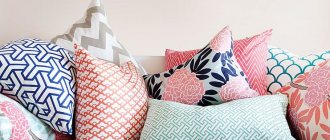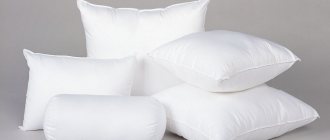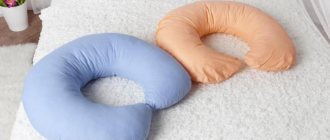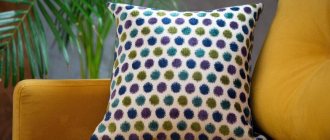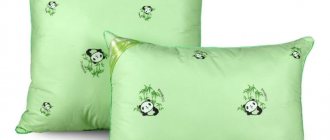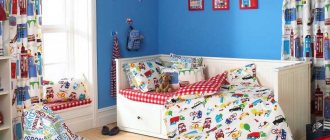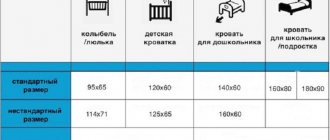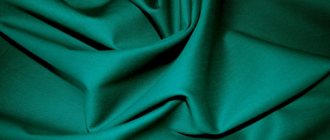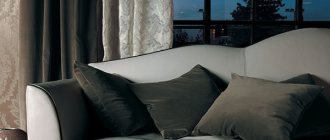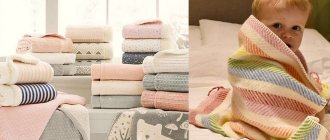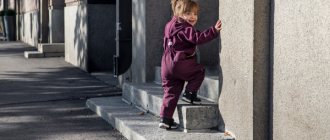The pillow supports your head while you sleep, prevents it from falling back and helps you relax your neck. In babies, the curves of the spine have not yet formed, so they do not need to put anything under their neck. But as soon as posture begins to form, it’s time to buy your baby a pillow. This occurs around the age of one or one and a half years. The question is individual, and if a child is over one and a half years old, but does not want to sleep on a pillow, there is no need to force him, but you should try to choose bedding that is comfortable for him.
At what age does a child need a pillow?
Young parents often try to prepare a beautiful soft pillow for their newborn baby and create, in their opinion, a comfortable and cozy environment in the stroller and crib.
This decision is absolutely wrong. What kind of pillow does a child need, and at what age should one be purchased?
In the first two years of life, a child does not need a pillow at all. The still unformed spine should be on a flat, hard surface. The pillow will contribute to its curvature in the area of the cervical vertebrae. In addition to problems with the spine, the baby may simply suffocate if he turns face down on the pillow.
There are anatomical pillows that completely follow the configuration of the child’s body, but there is still serious debate about their benefits. Experts have not yet found serious evidence of this fact. The need for their use is determined by medical indications and only on the recommendation of a pediatrician.
Rules for choosing a pillow
At two or three years old, when you can already buy a pillow for your child, you can think about buying it. You should remember about the orthopedic properties that it should have. The pillow should be:
- flat;
- low, ideally no more than 3 cm;
- medium hardness: the head should be well supported;
- small size, fits the width of the crib.
The best pillow for a child aged 2 to 7 years has a size of 50x40 cm. Its height does not have a strict standard and depends on the width of the shoulder, optimally from 2 to 10 cm. Accordingly, the older your son or daughter, the higher this figure.
Children over 7 years old can purchase an “adult” version of the pillow measuring 60x40 cm. The height is also selected individually.
It is important to choose a pillow with a special orthopedic configuration, that is, it should have a supporting cushion under the neck and a recess under the head. Only with this shape will the child’s spine be straight during sleep, both in the position on the back and on the side.
What's inside?
And inside we have a base. And it can be natural and artificial. I already wrote that for my daughter’s first time I bought a synthetic model. Why? Who knows what you might be allergic to? I followed a diet throughout my pregnancy and did not abuse complementary foods after birth. Followed the schedules. But the body is unpredictable! There is nothing for any microbes to eat in synthetics. For them, this is a completely “hungry environment.” These include databases from:
- Holofiber.
- Sintepon.
- Comfortel.
There are others too. Their main feature is hypoallergenicity. For the price, the synthetic padding polyester is the most reasonable, but it will also fall into disrepair sooner than others. It will form clumps when washed. I myself sleep on holofiber. Practically, when washing it can also go astray in one direction. But it gets over quickly. Now I wash it in a special bag, small in size. Nothing goes astray. Comfortel has the same qualities. They say it is more durable.
But there are also natural ingredients that are very welcomed by parents. I myself am for naturalness, only if the child has no allergies. Here you can dig around. The choice is wide.
Which filler should you prefer?
Filling is another important detail that it is recommended to pay attention to when choosing a pillow. It is made from various types of raw materials, that is, it can be natural or synthetic, soft or elastic, and has its own advantages and disadvantages. For a “correct” pillow, these indicators are in the optimal ratio and depend on the age of the child. It doesn’t matter whether you decide to choose a pillow for a child from the age of three or equip a sleeping place for a teenager, remember that natural ingredients can be allergens, and artificial ones are not always harmful to health. In the latter case, it all depends on the manufacturer.
A child’s sound and healthy sleep means peace and tranquility for the whole family.
If a mother rocks her baby to sleep all night, who will take care of him and the whole family during the day?
And a dad who is tired at work, who walks around the room like a zombie at night with a child in his arms... But he has to get up in the morning and go earn money! For healthy children's sleep, lifestyle, nutrition, temperature in the room, and, of course, the best friend of children's dreams - a comfortable pillow! Let us remind you that choosing a pillow for a child is a responsible matter, because the baby spends almost half of his life sleeping. The newborn sleeps most of the time, taking only short breaks for snacks. The older the baby gets, the less time he sleeps, and the more important sleep becomes. Sleep is necessary to “turn on” vital functions - the production of growth hormone, activation of T-lymphocytes (the main immune factor), processing and assimilation of information. No wonder the proverb “Sound sleep is the key to health”
Pillows with natural fillings
Natural fillers include fillers made from natural materials: fluff, sheep wool, latex, and parts of plants processed in a certain way.
It is traditionally believed that natural fillers are better than artificial ones, but they also have their drawbacks.
Down pillows
Pillow based on swan down Lonax Blu Ocean — 900 rub.
Down pillows have always been considered one of the most expensive. They are soft, quite elastic, easily take the shape of the head during sleep and also quickly restore their configuration. Down has excellent thermal insulation and hygroscopicity, which creates comfortable sleeping conditions in any weather. Pillows made of this material are lightweight and do not produce noise during operation.
One of the disadvantages is the need for careful processing of the down. A pillow made at home or in production, but with a violation of technology, will become a real breeding ground for dust mites that cause allergies. The softness of these pillows made them a no-no for young children whose spine has not yet fully formed.
Sheep wool pillows
Sheep wool is the second most popular natural filling for children's pillows. It, like down, has excellent breathability, hygroscopicity, and low thermal conductivity. Do not forget about its healing properties, thanks to the lanolin content in it.
Disadvantages also include the need for complex, multi-level treatment to avoid allergic reactions to dust mites. Wool quickly mats and becomes unusable. Soft pillows are not recommended for small children or people with spinal problems.
Natural latex pillows
An example of a pillow with natural latex granules: Promtex-Orient Lades - 1,800 rubles
The natural latex used in baby pillows is a solid piece of foam-like material with special holes made for ventilation. It has an orthopedic effect, hypoallergenic properties, is easy to care for, has a long service life and does not make noise during sleep.
This material has practically no disadvantages. An exception may be a possible allergy to latex (which is extremely rare), a specific smell of a new product (which also depends on the manufacturer) and high cost.
Pillows with natural plant fillings
Vegetable fillers have become more than popular recently. And this is not only latexed coconut coir, but also buckwheat husks and medicinal herbal mixtures.
These materials are hypoallergenic, and the herbal mixtures are also aromatic. They are well ventilated and have hygroscopic properties.
The disadvantages include a fairly high degree of rigidity, but for young children this fact can be considered more of a plus. Vegetable fillers, except coconut impregnated with latex, make a lot of rustling noise during use, which can bother children. When talking about coconut, it is worth mentioning the high price, but its quality is worth it.
Top 3. Ormatek Aqua Prim
Rating (2021): 4.63
An expensive but high-quality pillow from Ormatek is made of memory foam. On top of the main filler there is a special insert with a thermoregulating gel. It prevents the pillow from heating up from body heat and the environment. Even in the hottest weather, the surface remains pleasantly cool. Two bolsters, 9.5 and 12 cm high, provide support for the spine and correct body position during sleep. The pillow is quite high, so it is suitable only for teenagers over 13 years old; for younger children it is better to look at other options.
Characteristics:
4605 rub. / Russia / Filling: memory foam, thermoregulating gel
Pillows with synthetic fillings
Synthetic fillers: foam rubber, synthetic winterizer, polyurethane foam, holofiber - are no less popular than natural ones. For children, they are more suitable than natural ones, as they do not cause allergic reactions.
Among their advantages we can immediately name the affordable price. At the same time, manufactured by reliable manufacturers, they are not inferior in quality to natural ones.
Pillows with foam rubber and padding polyester
Foam rubber and synthetic winterizer are some of the most budget-friendly fillings for children's pillows on the market. In addition to the low price, the materials themselves do not cause allergic reactions, are hygroscopic, are well ventilated, and do not require complex care.
One of the disadvantages is the short service life: foam rubber loses its elastic shape, and synthetic padding falls off. Plus the ability to absorb moisture and dust makes them dangerous for children with allergies.
Polyurethane foam pillows
Example of a memory-based pillow: Promtex-Orient Memory - RUB 2,400
Polyurethane foam or artificial latex, memory are popular fillers for children's pillows with an orthopedic effect. The material is moderately soft and perfectly supports the head and neck in the correct position, which is especially important for children whose musculoskeletal system has not yet fully developed.
The disadvantages include a short service life, although it is much longer than that of foam rubber or padding polyester. This quality criterion is naturally reflected in the cost of the product. Another advantage of memory filler is the ability to perfectly follow the contours of the head during sleep.
Holofiber pillows
Like all synthetic materials, holofiber does not cause allergies, is well ventilated, and has moderate rigidity, which is good for children. During sleep, this filler does not make noise, is comfortable and cozy.
The problem with the disadvantages is the same - short service life. Considering that children grow quickly and in two or three years they will need a new, larger pillow, this minus can be considered not critical.
Correct position of the baby in your arms
Did you know that a child must be carried correctly in his arms from birth? It seems that it's as easy as shelling pears. It turns out not. The development of the infant's musculoskeletal system depends on the correct position of the baby in the arms.
- Classic. The child's head is placed on the elbow bend, while your forearm supports his back, and your palm supports his buttocks. You can support your baby's legs with your free hand.
- Column position. Hold your baby upright so that he lies on your chest and rests his cheek on your shoulder. At the same time, hold him by the back of his head and back with one hand, and by his buttocks with the other.
By following these simple recommendations, you will ensure your baby's proper development of the spine.
General rules for choosing a baby pillow
When deciding which pillow to choose for your child , it is recommended to consider a few tips that you should follow when purchasing.
- The height of the pillow should correspond to the width of the child’s shoulder, without exceeding it. The spine should maintain a horizontal position during sleep.
- The size of the pillow should match the size of the bed.
- The degree of hardness for children is recommended to be moderate.
- It is recommended to purchase pillows with natural fillings, primarily down, from trusted manufacturers who guarantee special processing of the material. It should be remembered that after five years of use the impregnation stops working and the pillow will have to be replaced.
- You should pay attention to the quality of the seams and the absence of unpleasant odors.
- It is recommended to purchase orthopedic pillows only after consulting a doctor.
